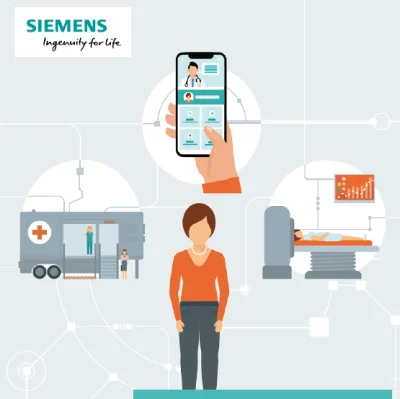Digitalisation
of healthcare helps to improve patient outcomes in a cost-efficient way. Therefore,
healthcare providers widely view it as a way to cope with the increasing demand
for healthcare services, caused by aging populations, rising levels of chronic
diseases and general changes in lifestyles.
New research from Siemens Financial Services (SFS) highlights three priority investment areas for digital transformation in global healthcare, estimates the expected capital investment and suggests ways of managing related financial challenges by healthcare organisations.
You
may also like: Smart Hospital Ethics: Starting the Dialogue
For Priority investment:investing in digital transformation in healthcare,
SFS has
conducted a global survey among healthcare professionals, including management
consultants, academic experts, national health departments, medical
associations and acute care organisations/groups, and identified three
following sectors as top priority for investment:
- New generation (digitalised and/or mobile) diagnostics
- Remote access and communications platforms (telemedicine)
- Smart, digitalised hospitals
New generation diagnostics
The global
diagnostic imaging market in 2018 totalled €27.2 billion ($29.9 billion). It is
expected to grow by 5.2% annually through to 2023, driven by the adoption of technology
in Asia. The ways how diagnostic
capabilities are administered and managed, as well as the performance of
diagnostic equipment are deeply affected by digitalisation. One example is digital
linkage through which deployment of devices in clinical settings may be
optimised, both in clinical and financial terms. Mobile diagnostic units (x-ray,
CT, ultrasound, MRI, mammography and nuclear imaging) would be another example,
as they allow for faster diagnosis and triage and more efficient usage of workforce
and equipment, maximising the delivered value.
Telemedicine
In 2018, the global telemedicine market stood at €19.5
billion ($21.4 billion), and it is expected to grow at 18.5% per year to 2024. Utilisation
of remote access and communications platforms addresses several important issues in healthcare. The
skills shortage common for many healthcare systems around the world, is
alleviated when a patient is able to consult a doctor remotely, which is
especially important for large countries with dispersed communities. Also, doctors
gain access to equipment and systems located elsewhere. Digital patient
monitoring is another area of rapid development. By 2024, the global sensor
market for medical wearables may reach €2.5 billion ($2.8 billion). Thus, according
to SFS, the key advantage of remote medicine is linking (a) hardware with
systems and (clinical) professionals and (b) doctors with patients.
Smart Digitalised Hospitals
It is
expected that the global smart hospital technology market will grow from €18.3
billion ($20.13 billion) in 2018 to €51.5 billion ($56.63 billion) in 2023. Smart hospital applications have
already proved their efficiency in many areas, from digitalised asset tracking,
which helps to significantly increase operating time by reducing delays and
cancellations, to digital dashboard capabilities. Not only are such
applications a valuable administrative tool but they also reduce the cost of
treatment.
Expected Investments
In the
next five years, SFS expects the global ‘investment challenge’ for these three
investment areas to require considerable financial inflows. In particular,
the capital needs for new generation diagnostic imaging will amount to €58.2
billion ($64 billion); for telemedicine, to €72 billion ($79 billion); for smart
hospitals, to €65.5 billion ($72 billion) across the five year period
2019-2023. For some countries, the respective numbers are:
- USA: €20.5 billion ($22.5 billion), €25.3 billion ($27.8 billion), €23 billion ($25.3 billion)
- China: €12.3 billion ($13.5 billion), €15.2 billion ($16.7 billion), €13.8 billion ($15.2 billion)
- UK: €1.36 billion ($1.54 billion), €1.64 billion ($1.9 billion), €1.55 billion ($1.7 billion)
- Germany: €4.3 billion ($4.7 billion), €5.3 billion ($5.8 billion), €4.7 billion ($5.2 billion)
These numbers
are beyond the capabilities of normal capital spending budgets available to
healthcare providers (usually set at around 5% of total operating budgets),
even to those with a centralised innovation budget.
The
majority of respondents indicated the importance of being able to acquire
digital transformation technology, equipment, skills and resources without the
need to ‘freeze’ the scares funding. This means that achieving digital
transformation largely depends on additional private sector finance. Another
point, highlighted in the report, is the importance of being able to ‘pay for
usage’ of technology, which is usually arranged around some form of leasing
structure.
Healthcare
organisations have different goals with regard to digitalisation. Among those
goals are: modernisation and upgrade of equipment and technology, increase of
performance and productivity, transition management, sustainable growth, etc. As
noted by SFS, in view of the above, financing solutions are increasingly being adapted
to healthcare organisations’ needs and circumstances, whether for a single
piece of technology or for a wholesome digital upgrade.
Full
report is available here.
Source: Siemens
Image credit: Siemens










